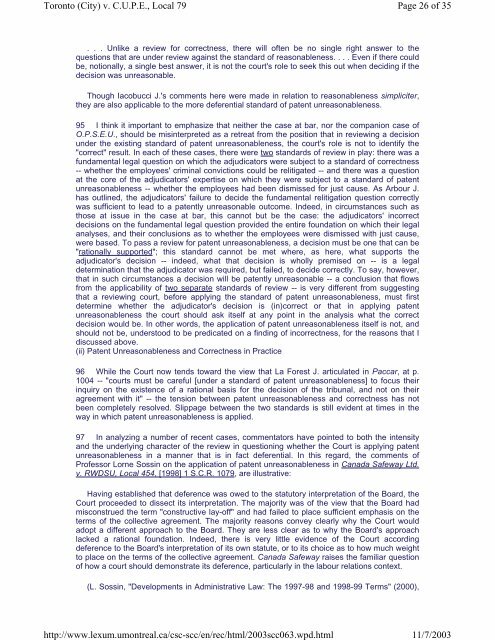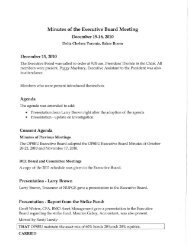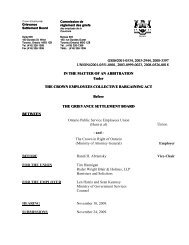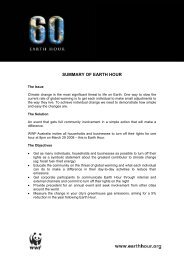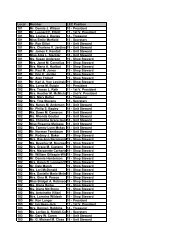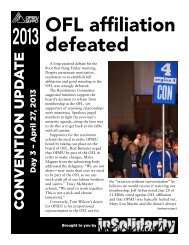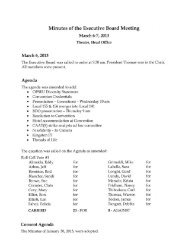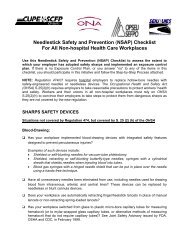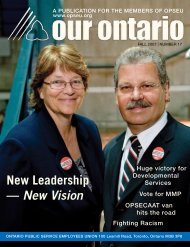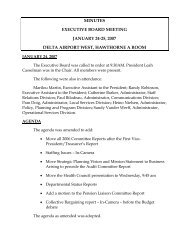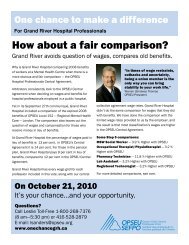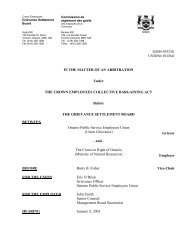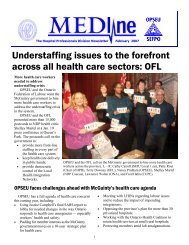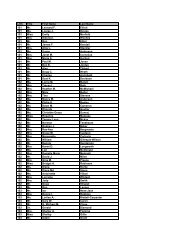C.U.P.E., Local 79 v. Toronto (City) .pdf - OPSEU
C.U.P.E., Local 79 v. Toronto (City) .pdf - OPSEU
C.U.P.E., Local 79 v. Toronto (City) .pdf - OPSEU
You also want an ePaper? Increase the reach of your titles
YUMPU automatically turns print PDFs into web optimized ePapers that Google loves.
<strong>Toronto</strong> (<strong>City</strong>) v. C.U.P.E., <strong>Local</strong> <strong>79</strong><br />
http://www.lexum.umontreal.ca/csc-scc/en/rec/html/2003scc063.wpd.html<br />
Page 26 of 35<br />
11/7/2003<br />
. . . Unlike a review for correctness, there will often be no single right answer to the<br />
questions that are under review against the standard of reasonableness. . . . Even if there could<br />
be, notionally, a single best answer, it is not the court's role to seek this out when deciding if the<br />
decision was unreasonable.<br />
Though Iacobucci J.'s comments here were made in relation to reasonableness simpliciter,<br />
they are also applicable to the more deferential standard of patent unreasonableness.<br />
95 I think it important to emphasize that neither the case at bar, nor the companion case of<br />
O.P.S.E.U., should be misinterpreted as a retreat from the position that in reviewing a decision<br />
under the existing standard of patent unreasonableness, the court's role is not to identify the<br />
"correct" result. In each of these cases, there were two standards of review in play: there was a<br />
fundamental legal question on which the adjudicators were subject to a standard of correctness<br />
-- whether the employees' criminal convictions could be relitigated -- and there was a question<br />
at the core of the adjudicators' expertise on which they were subject to a standard of patent<br />
unreasonableness -- whether the employees had been dismissed for just cause. As Arbour J.<br />
has outlined, the adjudicators' failure to decide the fundamental relitigation question correctly<br />
was sufficient to lead to a patently unreasonable outcome. Indeed, in circumstances such as<br />
those at issue in the case at bar, this cannot but be the case: the adjudicators' incorrect<br />
decisions on the fundamental legal question provided the entire foundation on which their legal<br />
analyses, and their conclusions as to whether the employees were dismissed with just cause,<br />
were based. To pass a review for patent unreasonableness, a decision must be one that can be<br />
"rationally supported"; this standard cannot be met where, as here, what supports the<br />
adjudicator's decision -- indeed, what that decision is wholly premised on -- is a legal<br />
determination that the adjudicator was required, but failed, to decide correctly. To say, however,<br />
that in such circumstances a decision will be patently unreasonable -- a conclusion that flows<br />
from the applicability of two separate standards of review -- is very different from suggesting<br />
that a reviewing court, before applying the standard of patent unreasonableness, must first<br />
determine whether the adjudicator's decision is (in)correct or that in applying patent<br />
unreasonableness the court should ask itself at any point in the analysis what the correct<br />
decision would be. In other words, the application of patent unreasonableness itself is not, and<br />
should not be, understood to be predicated on a finding of incorrectness, for the reasons that I<br />
discussed above.<br />
(ii) Patent Unreasonableness and Correctness in Practice<br />
96 While the Court now tends toward the view that La Forest J. articulated in Paccar, at p.<br />
1004 -- "courts must be careful [under a standard of patent unreasonableness] to focus their<br />
inquiry on the existence of a rational basis for the decision of the tribunal, and not on their<br />
agreement with it" -- the tension between patent unreasonableness and correctness has not<br />
been completely resolved. Slippage between the two standards is still evident at times in the<br />
way in which patent unreasonableness is applied.<br />
97 In analyzing a number of recent cases, commentators have pointed to both the intensity<br />
and the underlying character of the review in questioning whether the Court is applying patent<br />
unreasonableness in a manner that is in fact deferential. In this regard, the comments of<br />
Professor Lorne Sossin on the application of patent unreasonableness in Canada Safeway Ltd.<br />
v. RWDSU, <strong>Local</strong> 454, [1998] 1 S.C.R. 10<strong>79</strong>, are illustrative:<br />
Having established that deference was owed to the statutory interpretation of the Board, the<br />
Court proceeded to dissect its interpretation. The majority was of the view that the Board had<br />
misconstrued the term "constructive lay-off" and had failed to place sufficient emphasis on the<br />
terms of the collective agreement. The majority reasons convey clearly why the Court would<br />
adopt a different approach to the Board. They are less clear as to why the Board's approach<br />
lacked a rational foundation. Indeed, there is very little evidence of the Court according<br />
deference to the Board's interpretation of its own statute, or to its choice as to how much weight<br />
to place on the terms of the collective agreement. Canada Safeway raises the familiar question<br />
of how a court should demonstrate its deference, particularly in the labour relations context.<br />
(L. Sossin, "Developments in Administrative Law: The 1997-98 and 1998-99 Terms" (2000),


